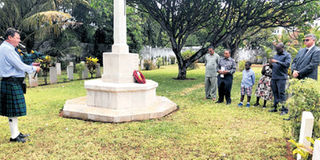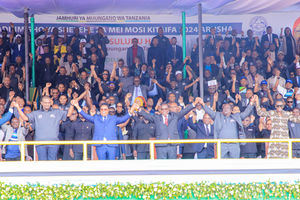World War I centennial celebrated in Tanzania

What you need to know:
- Dar es Salaamm over the weekend celebrated the 100th anniversary of the Armistice that brought an end to the global conflict from 1914 to 1918
Dar es Salaam. The seismic impact of the First World War in East Africa was remembered at a poignant monument in the heart of Dar es Salaam, marking the 100th anniversary of the Armistice that brought an end to the global conflict from 1914 to 1918.
The annual remembrance ceremony, which includes multi-faith prayers, was held at the Commonwealth War Graves at Kijitonyama in Dar es Salaam. It was jointly hosted by the British High Commissioner and the Germany ambassador to Tanzania.
The traditional guard of honour and parade by the Tanzania People’s Defence Force (TPDF) was attended by members of the diplomatic corps, Tanzanian military veterans, and people representing Dar es Salaam’s diversified civil society.
For this centennial year, the ceremony was also graced by the minister for Justice and Constitutional Affairs, Prof Palamagamba Kabudi whose opening statement paid respect to those buried at the War Graves and remembered the unknown number of African troops, porters and civilians who died without burial.
A special wreath laying ceremony then followed at the Askari Monument in the city centre and the official ceremonies concluded at a breakfast gathering hosted by the Embassy of Germany in the recently renovated Old Boma building.
After the official schedule ended, two community-organised events then followed organised jointly by Rajab Katunda of the Association of UK Alumni Students, David Sawe of British Legion Tanganyika Club and Antony Shaw in the UK as a joint Tanzania-UK initiative.
In a brief ceremony attended by senior staff from the Tanzania Postal Corporation (TPC), ex-service personnel from the international community and members from the British Legion Tanganyika Club, a wreath was laid at the Old Post Office on Sokoine Drive to honour the fallen from the Royal Engineers’ East African Signal Service and the Tanganyika Labour Corps who supported the unit.
The Signals Service was made up of technicians, linesmen, drivers, motorcyclists and pioneers from across East Africa, many of whom had been ordinary postal and telegraph workers in their civilian lives.
Those who had served in this valiant multi-national unit sustained extremely heavy casualties in ensuring that vital communications links for the British forces were kept open at all times during the war.
In partnership with their counterparts in India, they also decrypted coded messages transmitted among the German forces, which they were able to intercept.
Among their challenges were lines broken by elephants leaning on telegraph poles and giraffes accidentally walking into the cables with their tall necks. The memory of these brave men is preserved on a wall beside the entrance to the very historic building, popularly known as “Posta ya Zamani” (old Post Office). During this special ceremony to lay the wreath sent annually by the UK Royal Engineers’ Association, appreciation was given to the Post Master General and his team for preserving the unique marble monument at the historic building as a poignant reminder of the conflict that also affected Tanzania.
In a further remembrance ceremony, a wreath that had been sent jointly by the UK King’s African Rifles and the East African Forces Association, was laid at the Commonwealth War Graves cemetery in Upanga.
This honoured the heroism and gallantry of ‘Askaris’ who fought in both World Wars and in other campaigns since then.
Lasting over four years and impacting the lives of millions of people, the East African campaign remains one of the least known theatres of the ‘Great War’.
The General Secretary of the British Legion Tanganyika Club, Mr Sawe, who attended these community-led ceremonies remarked: “Tanzanians should also spare a thought for our shared ancestors whose anonymous remains were scattered all across our country by that war, some into unmarked graves, others wherever they fell or sank, and yet others dispersed by the scavenging wildlife.”
The majority of the 250,000 soldiers involved in the war included Africans (from East Africa, Nigeria and present-day Ghana), Caribbean nationals and Indians.
It was the war’s longest campaign as it began on August 3, 1914 and ended on November, 25, 1918 when the German forces finally surrendered, barely two weeks after the Armistice was signed on November 11, 1918.




